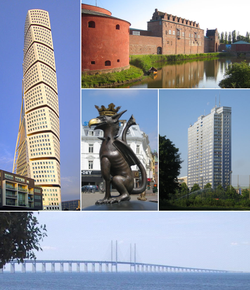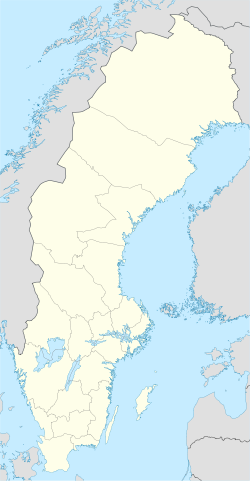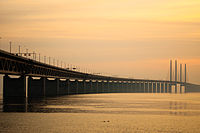- Malmö
-
"Malmo" redirects here. For the village in Nebraska, U.S., see Malmo, Nebraska.For ships named Malmö, see SS Malmö.
Malmö From top left to right: Turning Torso, Malmöhus Castle, Griffin Sculpture, Kronprinsen and the Øresund Bridge. 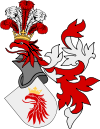
Coat of armsMotto: Mångfald, Möten, Möjligheter
(Eng.: Diversity, Meetings, Possibilities)Coordinates: 55°35′N 13°02′E / 55.583°N 13.033°ECoordinates: 55°35′N 13°02′E / 55.583°N 13.033°E Country Sweden Province Scania County Skåne County Municipality Malmö Municipality and
Burlöv MunicipalityCharter 13th century Area[1] – City 335.14 km2 (129.4 sq mi) – Land 155.56 km2 (60.1 sq mi) – Water 179.58 km2 (69.3 sq mi) – Urban 76.81 km2 (29.7 sq mi) – Metro 2,535.76 km2 (979.1 sq mi) Population (30 June 2011)[1][2][3] – City 300,515 – Density 1,931.8/km2 (5,003.3/sq mi) – Urban 280,415 – Urban density 3,650.8/km2 (9,455.4/sq mi) – Metro 658,704 – Metro density 259.8/km2 (672.8/sq mi) Time zone CET (UTC+1) – Summer (DST) CEST (UTC+2) Website www.malmo.se www.malmotown.com Malmö (Swedish pronunciation: [ˈmalːˈmøː] (
 listen)), in the southernmost province of Scania, is the third most populous city in Sweden, after Stockholm and Gothenburg.
listen)), in the southernmost province of Scania, is the third most populous city in Sweden, after Stockholm and Gothenburg.Malmö is the seat of Malmö Municipality and the capital of Skåne County. The administrative entity for most of the city is Malmö Municipality which has 300,515 inhabitants in eight different localities, with 30% being of foreign origin (either born outside of Sweden or having both parents born abroad).[2] Malmö is also a bimunicipal locality, as part of it is Burlöv Municipality. The total population of the urban area was 280,415 by the start of 2011[1].
Greater Malmö is one of Sweden's three officially recognized Metropolitan areas and since 2005 is defined by the municipality of Malmö and 11 other municipalities in the southwestern corner of Scania.[4] On 30 June 2008, its population was recorded to be 628,388.[3] The region covers an area of 2,535.76 square kilometres (979.06 sq mi).[5] The municipalities included, apart from Malmö, are Burlöv, Eslöv, Höör, Kävlinge, Lomma, Lund, Skurup, Staffanstorp, Svedala, Trelleborg and Vellinge. Lund, with a municipal population of over 100,000 and home to one of Scandinavia's major universities, is together with Malmö the region's economic and education hub.
Malmö was one of the earliest and most industrialized towns of Scandinavia, but it struggled with the adaptation to post-industrialism. Since the construction of the Öresund bridge, Malmö has undergone a major transformation with impressive architectural developments, attracting new biotech and IT companies, and particularly students through Malmö University College. The city contains many historic buildings and parks, and is also a commercial centre for the western part of Scania. During the last few years a university college (Malmö University) has been established and the city is now trying to focus on education, arts and culture. Malmö was ranked #4 in Grist Magazine's "15 Green Cities" list in 2007.[6]
Contents
History
Main article: History of MalmöMalmö is thought to have been founded in the year 1275, as a fortified quay or ferry berth of the Archbishop of Lund, some 20 km to the north-east. It was, for centuries, Denmark's second biggest city. Its original name was Malmhaug (with alternate spellings), meaning "Gravel pile".
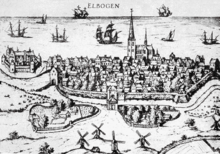 Malmö in 1580 in a German map book. The Malmö Castle is to the far left. The church tower is that of Saint Peter's Church.
Malmö in 1580 in a German map book. The Malmö Castle is to the far left. The church tower is that of Saint Peter's Church.
In the 15th century, Malmö became one of Sweden's largest and most frequented cities, reaching a population of approximately 5,000 inhabitants. It became the most important city around the Sound, with the German Hanseatic League frequenting it as a marketplace, notable for its flourishing herring fishing. During that time, the city arms were granted in 1437 by King Eric of Pomerania. It was based on Eric's own arms from Pomerania: an argent with a griffin gules. It gave the griffin's head to Malmö, eventually this extended to the entire province of Scania.
In 1434, a new citadel was constructed at the beach south of the town. This fortress, known today as Malmöhus, did not get its current appearance until the mid-16th century. Several other fortifications were constructed, making Malmö Sweden's most fortified city, but only Malmöhus remains.
Lutheran teachings became popular during the 16th century, and Malmö was one of the first cities in Scandinavia to fully convert (1527–29).
In the 17th century, Malmö and the Scanian region (Skåneland) came into Swedish possession. This happened following the Treaty of Roskilde, signed in 1658. Fighting was not yet over, however; in June 1677, 14,000 Danish troops laid siege to Malmö for a month, but were unable to conquer the Swedish troops holding it.
By the dawn of the 18th century, Malmö had about 2,300 inhabitants. However, due to the wars of Charles XII of Sweden and plague epidemics, the population dropped to 1,500 by 1727. The population did not grow much until the modern harbour was constructed by the late 18th century. The city started to expand, and in the year 1800 had 38,054 inhabitants.[7]
In 1840, the Kockums shipyard was founded and it eventually became one of the largest shipyards in the world. Between 1856 and 1864 the Southern Main Line was built and enabled Malmö to become a center of manufacture, with big textile and mechanical industries. In 1870, Malmö overtook Norrköping to become Sweden's third most populous city and by 1900 Malmö had strengthened this position with 60,000 inhabitants. Malmö continued through the first half of the 20th century. The population had swiftly increased to 100,000 by 1915 and to 200,000 by 1952. By 1971, Malmö reached 265,000 inhabitants, but this was the peak which would stand for more than 30 years.[citation needed]
By the mid 1970s, Sweden experienced a recession that struck especially hard on the industrial sector; shipyards and manufacturing industries were hard hit, which led to high unemployment in many cities of Scania. Kockums shipyard had become a symbol of Malmö as its greatest employer and when the shipbuilding ceased in 1986 the reassurance for the future of Malmö plummeted among politicians and the public. In addition, many middle class families moved into one-family houses in surrounding municipalities such as Vellinge Municipality, Lomma Municipality and Staffanstorp Municipality which profiled themselves as the suburbs of the upper middle class. By 1985, Malmö had lost 35,000 inhabitants and was down to 229,000.
The Swedish financial crises of the early 1990s exacerbated Malmö's decline as an industrial city; between 1990-95, Malmö lost about 27,000 jobs and its economy was seriously strained. However, from 1994 and under the leadership of the new mayor Ilmar Reepalu , the city of Malmö started to re-conceptualize itself as a center of culture and knowledge. Malmö reached bottom in 1995 and the same year marked the commencement of the massive Øresund Bridge project. A new college, Malmö Högskola, was opened in 1998 on Kockums' former dockside and further redevelopment of the now disused south-western harbor followed; a city architecture exposition (Bo01) was held in the area in 2001 and its buildings and villas forms the core of a new city district, aimed at the urban middle-class and with attractive waterfront vistas.
Since the 1974 the Kockums Crane had been a landmark in Malmö and a symbol of the city's manufacturing industry, but in 2002 it was disassembled and moved to South Korea. In 2005 Malmö got a new landmark with completion of Turning Torso, the tallest skyscraper in Scandinavia. Although, the transformation from a city with its economic base in manufacturing have returned growth to Malmö, it have largely benefited the already somewhat well-off. Malmö has the highest proportion of individuals of non-Scandinavian extraction of any Swedish city. And while the inner city are being gentrified and the upper-middle class have inhabited the Western Harbor, little have changed for the inhabitants of in the districts of the Million Programme; Malmö remains a city of sharp social divide and high unemployment.
At the 27th of April, 2011 Malmö reached 300,000 inhabitants.[8]
Geography
Malmö Climate chart (explanation) J F M A M J J A S O N D 492−3302−3405−13810241167522011612113582112591710571276173584−1Average max. and min. temperatures in °C Precipitation totals in mm Source: World Weather Information Service[9] Imperial conversion J F M A M J J A S O N D 1.936271.236271.641301.550361.66145268522.470552.370542.363502.254452.445372.33930Average max. and min. temperatures in °F Precipitation totals in inches Malmö is located at 13°00' east and 55°35' north. Its location in southernmost Sweden makes it closer to the Italian city of Milan than to the northernmost Swedish town Kiruna.
Malmö is part of the transnational Oresund Region and since 2000 the Øresund Bridge crosses the Sound to Copenhagen, Denmark. The bridge was inaugurated 1 July 2000, and measures 8 kilometres (the whole link totalling 16 km), with pylons reaching 204.5 metres vertically. Apart from the Helsingborg-Helsingør ferry links further north, most ferry connections have been discontinued.
Climate
Malmö, like the rest of southern Sweden, has an oceanic climate. Despite its northern location, the climate is relatively mild compared to other locations in similar latitudes, or even somewhat farther south, mainly because of the Gulf Stream. Because of its northern latitude, daylight extends 17 hours in midsummer, to only around 7 hours in midwinter.
Summers are warm and pleasant with average high temperatures of 20 to 21 °C (68 to 70 °F) and lows of around 11 to 13 °C (52 to 55 °F), but temperatures do sometimes exceed 25 °C (77 °F) and occasional heat waves are common during the summer. Winters are cold, with temperatures steady between -3 to 4 °C (27 to 39 °F), and it rarely drops below −10 °C (14 °F).
Rainfall is light to moderate throughout the year with 169 wet days. Snowfall occurs mainly in December through March, but snow covers do not remain for a long time[citation needed], and some winters are virtually free of snow.
Climate data for Malmö Month Jan Feb Mar Apr May Jun Jul Aug Sep Oct Nov Dec Year Average high °C (°F) 2
(36)2
(36)5
(41)10
(50)16
(61)20
(68)21
(70)21
(70)17
(63)12
(54)7
(45)4
(39)11.4 Average low °C (°F) −3
(27)−3
(27)−1
(30)2
(36)7
(45)11
(52)13
(55)12
(54)10
(50)7
(45)3
(37)−1
(30)4.8 Precipitation mm (inches) 49
(1.93)30
(1.18)40
(1.57)38
(1.5)41
(1.61)52
(2.05)61
(2.4)58
(2.28)59
(2.32)57
(2.24)61
(2.4)58
(2.28)604
(23.78)Avg. precipitation days 17 13 14 12 12 12 14 13 14 15 17 16 169 Source: World Weather Information Service[9] Transport
Oresundtrains cross Øresund Bridge every 20 minutes (every 10 minutes during rush hour) connecting Malmö to Copenhagen, and the Copenhagen Airport. Also some of the X 2000 and Intercity trains to Stockholm, Gothenburg, and Kalmar cross the bridge, stopping at Copenhagen Airport. In March 2005, digging began on a new railway connection called the City Tunnel, which opened for traffic on December 4 2010. The tunnel runs from under Malmö Central Station to Triangeln continuing to Hyllievång (Hyllie Meadow), where it emerges to connect with the Øresund Bridge, effectively changing Malmö Central from being a terminus to being a transit station.
Besides the Copenhagen Airport, Malmö has an airport of its own, Malmö Airport, today chiefly used for low-cost carriers, charter flight routes, and domestic Swedish destinations.
The motorway system has been incorporated with the Øresund Bridge; the European route E20 goes over the bridge and then, together with the European route E6 follows the Swedish west coast from Malmö–Helsingborg to Gothenburg. E6 goes further north along the west coast and through Norway to the Norwegian town Kirkenes at Barents Sea. The European route to Jönköping–Stockholm (E4) starts at Helsingborg. Main roads in direction of Växjö–Kalmar, Kristianstad–Karlskrona, Ystad (E65), and Trelleborg start as freeways.
Malmö has 410 kilometres (250 mi) of bike paths and approximately 40% of all commuting is done by bicycle.
Malmö has 2 industrial harbours; one is still in active use and is the biggest Nordic port for car importation.[10] Also, there are two marinas: the publicly owned Limhamn Marina (55°35′N 12°55′E / 55.583°N 12.917°E) and the private Lagunen (55°35′N 12°56′E / 55.583°N 12.933°E), both offering a limited number of guest docks. Free marine charts are available.
Municipality
Main article: Malmö MunicipalityMalmö Municipality is an administrative unit defined by geographical borders, consisting of the City of Malmö[11] and its immediate surroundings.
The Malmö urban area, Malmö tätort consists of the urban part of the municipality together with the small town of Arlöv in the municipality of Burlöv. Both municipalities also include smaller urban areas and rural areas, such as the suburbs of Oxie and Åkarp. Malmö tätort is to be distinguished from Malmö stad (the city of Malmö), which is a semi-official name of Malmö Municipality.
Demographics
Main article: Demographics of MalmoAfter 1971, Malmö had 265,000 inhabitants, the population then dropped to 229,000 by 1985.[12] It then began to rise again, and had passed the previous record by the 1 January 2003 census, when it had 265,481 inhabitants.[13]
30% of Malmö's inhabitants, 87,554 persons, are born abroad[14] and even without counting second generation immigrants, this places Malmö as the Swedish city with the most immigrants per capita.
The largest groups of immigrants have arrived from:[15] Former Yugoslavia (14,450)
Former Yugoslavia (14,450) Iraq (10,000)
Iraq (10,000) Denmark (9,200)
Denmark (9,200) Poland (6,900)
Poland (6,900) Lebanon (3,900)
Lebanon (3,900) Iran (3,600)
Iran (3,600) Palestine (2,500)
Palestine (2,500) Turkey (2,300)
Turkey (2,300) Afghanistan (2,100)
Afghanistan (2,100) Romania (2.050)
Romania (2.050)
As of 2005, Malmö had the third-highest proportion of foreign-born residents of any municipality in Sweden.[16] There were 171 different nationalities represented in Malmö in 2007.
Economy
The economy of Malmö was traditionally based on shipbuilding (Kockums) and construction related industries, such as concrete factories. The region's leading university, along with its associated hi-tech and pharmaceutical industries, is located in Lund about 16 km to the north-east. As a result, Malmö had a troubled economic situation following the mid-1970s. Between 1990-1995, 27,000 jobs were lost, and the budget deficit was more than one billion Swedish krona. In 1995, Malmö had Sweden's highest unemployment rate[citation needed]
However, during the last few years there has been a revival. The main contributing factor has been the economic integration with Denmark brought about by the Øresund Bridge. Almost 10% of the population[citation needed] in Malmö works in Copenhagen, Denmark . Also the university college (Malmö Högskola) founded in 1998 and the effects of integration into the European Union have contributed.
Malmö still has comparatively high unemployment figures[citation needed], particularly among the ethnically and socially diverse areas in the eastern and southern parts. In 2004, the rate of wage-earners was 63%, compared to 74% in Stockholm and 71% in Gothenburg.[17] This in turn lead to Malmö municipality in 2007 having the 9th lowest median income in Sweden,[18] ranked far below the other larger Swedish cities Stockholm (31st) and Gothenburg (94th).
As of 2005, the largest companies were:[19]
- Skanska – heavy construction: 3,025 employees
- ISS Facility Service AB – hospital service, cleaning, etc.: 1,725 employees
- E.ON Sverige – electricity: 1,025 employees
- Sydsvenskan – newspaper: 1,025 employees
- Pågen – bakery: 975 employees
Education
Malmö has the country's eighth largest school of higher education with the university college Malmö Högskola established in 1998. It has 1,400 employees and 23,900 students (as of 2011).
In addition, the venerable Lund University (established in 1666) has some education located in Malmö:
- Malmö Art Academy (Konsthögskolan i Malmö)
- Malmö Academy of Music (Musikhögskolan i Malmö)
- Malmö Theatre Academy (Teaterhögskolan i Malmö)
- The Faculty of Medicine, which is located in both Malmö and Lund.
The UN World Maritime University is also located in Malmö. The World Maritime University (WMU)[20] operates under the auspices of the International Maritime Organization (IMO), a specialized agency of the United Nations. WMU thus enjoys the status, privileges and immunities of a UN institution in Sweden.
Culture
A striking depiction of Malmö was made by Bo Widerberg in his engaging debut film Kvarteret Korpen (Raven's End) (1963), largely shot in the shabby Korpen working-class district in Malmö. With humour and tenderness it depicts the tensions between classes and generations. The movie was nominated for an Academy Award for Best Foreign Language Film in 1965.
Theatre
In 1944, one of the city's most enduring cultural hubs was inaugurated, Malmö Stadsteater (Malmö Municipal Theatre) with a repertory embracing both stage theatre, opera, musical, ballet, musical recitals and theatrical experiments. In 1993 it was split into three separate units, Dramatiska Teater (Dramatical Theatre), Malmö Musikteater (Music Theatre) and Skånes Dansteater (Scanian Dance Theatre) and the name was abandon. When the ownership of the last two where transferred to Region Skåne in 2006 Dramatiska Teatern retained its old name. In the 1950s Ingmar Bergman was the Director and Chief Stage Director of Malmö Stadsteater and many of his actors, like Max von Sydow and Ingrid Thulin were brought to stardom through his films. Later stage directors include Staffan Valdemar Holm and Göran Stangertz.[21] Malmö Musikteater were renamed Malmö Operan and plays operas and musicals, classics as newly composed, on one of Scandinavia's largest opera scenes with 1,511 seats.[22] Skånes dansteater is also active and plays contemporary dance repertory and present works by Swedish and international choreographers in their house in Malmö harbour.[23]
Since the 1970s the city has also been home to a rich, if fluctuating, array of independent theatre groups and some show/musical companies. It also hosts a rich rock/dance/dub culture; in the 1960s The Rolling Stones played the Klubb Bongo, and in recent years stars like Morrissey, Nick Cave, B.B. King and Pat Metheny have made repeated visits.
The Cardigans made their start in Malmö and recorded their albums there. On 7 January 2009 CNN Travel broadcasted a segment called "MyCity_MyLife" featuring Nina Persson taking the camera to some of the sites in Malmö that she enjoys.
The Rooseum Centre for Contemporary Art, founded in 1988 by the Swedish art collector and financier Fredrik Roos and housed in a former power station which had been built in 1900, was one of the foremost centres for contemporary art in Europe during the 1980s and 1990s. By 2006, most of the collection had been sold off and the museum was on a time-out; by 2010 Rooseum had been dismantled and a subsidiary of the national Museum of Modern Design inaugurated in its place.
Museums
On 26 December 2009, Moderna Museet ("the modern museum") opened its first outpost in the old Rooseum building in Malmö. The collection of Moderna Museet holds key pieces of, among others, Marcel Duchamp, Louise Bourgeois, Pablo Picasso, Niki de Saint Phalle, Salvador Dalí, Carolee Schneemann, Henri Matisse och Robert Rauschenberg[24][25] The Malmö Konsthall is one of the largest exhibition halls in Europe for contemporary art, opened in 1975.[26]
Architecture
 Jugendstil Malmö synagogue
Jugendstil Malmö synagogue
Malmö's oldest building is St Peter's Church. It was built in the early 14th century in Baltic Brick Gothic probably after St Mary's Church in Lübeck. The church is built with a nave, two aisles, a transept and a tower. Its exterior is characterized above all by the flying buttresses spanning its airy arches over the aisles and ambulatory. The tower, which fell down twice during the 15th century, got its current look in 1890.[27]
Another old building is Tunneln, 300 metres (1,000 ft) to the west of St Peter's church, which also dates back to around 1300.
The oldest parts of Malmö were built between 1300-1600 during its first major period of expansion.[citation needed] The central city's layout as well as some of its oldest buildings are from this time. Many of the smaller buildings from this time are typical Scanian: two story urban houses that show a strong Danish influence.[citation needed]
Recession followed in the ensuing centuries. The next expansion period was in the mid 19th century and led to the modern stone and brick city. This expansion lasted into the 20th century and can be seen by a number of Jugendstil buildings for which the city is known, including the Malmö synagogue. Malmö was relatively late to be influenced by modern ideas of functionalist tenement architecture in the 1930s. Around 1965, the government initiated the so-called Million Programme, intending to offer affordable apartments in the outskirts of major Swedish cities. But this period also saw the reconstruction (and razing) of much of the historical city centre.[citation needed]
Recent years have seen a bolder, more cosmopolitan architecture. Västra Hamnen (The Western Harbour), like most of the harbour to the north of the city centre, was industrial. In 2001, however, its reconstruction began as an exclusive, albeit secluded, urban residential neighbourhood. The 500 dwelling units are extremely unique and inventive, and most were part of the exhibition Bo01.[citation needed] The exhibition had two main objectives: develop self-sufficient housing units in terms of energy and greatly diminish phosphorus emissions. Among the new buildings towers the Turning Torso, a spectacular twisting skyscraper, 190 metres (620 ft) tall, the majority of which is residential. It quickly became Malmö's new landmark within Sweden.[28][29]
Other sights
The beach Ribersborg in the western harbour, is a man-made shallow beach, stretching along Malmö's coastline. Despite Malmö's chilly climate, it is sometimes referred to as the "Riviera of the North" or the "Swedish Riviera". It is the site of Ribersborgs open-air bath, opened in the 1890s.
The long boardwalk at The Western Harbour has become a new favourite summer hang-out for the people of Malmö and is a popular place for bathing. The harbour is particularly popular with Malmö's vibrant student community and has been the scene of several impromptu outdoor parties and gatherings.
Events
In the third week of August each year a festival, Malmöfestivalen, fills the streets of Malmö with different kinds of cuisines and events.[30]
BUFF, the International Children and Young People's Film Festival in Malmö, takes place every year in March.
In 1914 the Baltic Exhibition was held in Malmö which consisted of exhibitions about industry, art and crafts from Sweden, Denmark, Germany and Russia. In 1992 Malmö was the host of the Eurovision Song Contest 1992, after Sweden won it the previous year.
The Nordic Games Conference, one of the most important events in the game development industry, takes place in Malmö every May.[citation needed] The event consists of conference itself, recruitment expo and game expo and attracts hundreds of gamedev professionals every year.
Malmö hosts many other different types of contests and special events in Entré, inside the city centre. These include the events such as the Swedish version of Oktoberfest, modelling catwalk contests showing the latest fashion to jackets and coats, to lingerie and garments.
Malmö also known to host other 3rd party events that cater to all communities that reside in Malmö, including religious and political celebrations.
Media
Sydsvenska Dagbladet, founded in 1870, is Malmö's largest daily newspaper, and also one of its larger employers (see section Economy). It has an average circulation of 130,000. Its main competitor is the regional daily Skånska Dagbladet, which has a circulation of 34,000. In addition to these, a number of free-of-charge papers, generally dealing with entertainment, music and fashion have local editions (for instance City, Rodeo, Metro and Nöjesguiden). Malmö is also home to the Egmont media group's Swedish magazine operations. A number of local and regional radio and TV broadcasters are based in the Greater Malmö area.
Sports
 Swedbank Stadion, The home of Malmö FF
Swedbank Stadion, The home of Malmö FF
 Malmö Arena, the home of Malmö Redhawks
Malmö Arena, the home of Malmö Redhawks
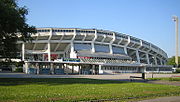 Malmö Stadion, The former home of Malmö FF
Malmö Stadion, The former home of Malmö FF
Sports in southern Sweden is dominated by football. Over the years the city's best football team has been Malmö FF who play in the top level Allsvenskan. They had their most successful periods in the 1970s and 1980s, when they won the league several times. In 1979, they advanced to the final of the European Cup defeating AS Monaco, Dynamo Kiew, Wisla Krakow and Austria Vienna but lost in the final at the Munich Olympic Stadium against Nottingham Forest by a single goal just before half time scored by Trevor Francis. To date, they are the only Swedish football club to have reached the final of the competition. Malmö FF is the club where Zlatan Ibrahimović began his professional football career. A second football team, IFK Malmö played in Sweden's top flight for about 20 years and the club's quarterfinal in the European Cup is the club's greatest achievement in its history. Today, the club resides in the sixth tier of the Swedish league system. Examples of other Malmö based clubs are IF Limhamn Bunkeflo and FC Rosengård. Both in Division 1 South, the third tier. Held in Sweden, Malmö was one of the four cities to host the 2009 UEFA European Under-21 Football Championship and hosted the final.
The most notable other sports team is the ice hockey team Malmö Redhawks. They were the creation of millionaire Percy Nilsson and quickly rose to the highest rank in the early to mid-1990s and won two Swedish championships, but for a number of years have found themselves residing outside of the top flight. Malmö also has teams that play first division handball HK Malmö, baseball, American football and Australian football. Of these last mentioned sports only handball attracts a fair amount of attendance. Gaelic football has also been introduced to Malmö, with the new Malmö G.A.A. club winning the Scandinavian Championships in their inauguaral year, 2009, and are again in the running for 2011.
Among non-team sports badminton and athletics are the most popular together with east Asian martial arts and boxing. Basketball is also fairly a big sport in the city, including the clubs Malbas and SF Srbija among others.
Women are permitted by the city council to swim topless in public swimming pools.[31][32] Everyone must wear bathing attire, but covering of the breasts is not mandatory.[33] "We don’t decide what men should do with their torso, why then do women have to listen to the men. Moreover, many men have larger breasts than women", remarked a council spokesman.[34]
See also
- Oresund Region
- Ports of the Baltic Sea
- List of people connected to Malmö
- Governors of Malmö
- Chronicle of the Expulsion of the Grayfriars#Chapter 4 Concerning the Friary in Malmø
- Bulltofta Airport
References
- Facts & Figures about Malmö, 2005PDF – in English. From the municipal webpage, PDF format.
- "Malmö stad — Statistik". Malmö.se. http://www.malmo.se/faktaommalmopolitik/statistik.4.33aee30d103b8f15916800028279.html. Retrieved 2010‑02‑05. (Swedish)
- Notes
- ^ a b c "Tätorter 2010" (in Swedish with English summary) (pdf). Statistics Sweden. http://www.scb.se/statistik/MI/MI0810/2010A01/MI0810_2010A01_SM_MI38SM1101.pdf. Retrieved 2011-09-26.
- ^ a b Necmi Incegül. "Statistik om Malmö - Malmö stad". Malmo.se. http://www.malmo.se/Kommun--politik/Om-oss/Statistik-om-Malmo.html. Retrieved 2011-09-15.
- ^ a b (Statistics Sweden) Folkmängd i riket, län och kommuner 30 juni 2011 och befolkningsförändringar första halvåret 2011 (in Swedish) Retrieved on 2011‑10‑19.
- ^ (Statistics Sweden) Storstadsområden (excel-file, in Swedish) Definitions of Metropolitan Areas in Sweden. Retrieved on 2008‑10‑12.
- ^ (Statistics Sweden) Kommunarealer den 1 January 2008 (excel-file, in Swedish) Municipalities in Sweden and their areas, as of 1 January 2008. Retrieved on 2008‑10‑12.
- ^ by Grist (2007-07-19). "15 Green Cities". Grist. http://www.grist.org/article/cities3/. Retrieved 2011-09-15.
- ^ Encyclopædia Britannica Eleventh Edition (1911), article Malmö
- ^ "Nu är vi över 300 000 - Malmö - Sydsvenskan - Nyheter dygnet runt". Sydsvenskan.se. 2011-04-27. http://www.sydsvenskan.se/malmo/article1452296/Nu-ar-vi-over-300-000.html. Retrieved 2011-09-15.
- ^ a b "Weather Information for Malmö". World Weather Information Service. July 2011. http://www.worldweather.org/096/c01041.htm. Retrieved 16 September 2010.
- ^ "CMP". Cmport.com. 2010‑01‑15. http://www.cmport.com/. Retrieved 2010‑02‑05.
- ^ In all official contexts, the town Malmö calls itself "Malmö stad" (or City of Malmö), as does a small number of other Swedish municipalities, and especially the other two metropolitans of Sweden: Stockholm and Gothenburg. However, the term city has administratively been discontinued in Sweden.
- ^ Nationalencyklopedin, Article Malmö
- ^ "Befolkningsprognos för Malmö" (in se). Malmö Stad. http://www.malmo.se/faktaommalmopolitik/statistik/01befolkning/befolkningsprognosformalmo.4.33aee30d103b8f15916800028318.html. Retrieved 2007‑12‑29.
- ^ "Malmöbor med utländsk bakgrund". Malmö stad. http://malmo.se/Kommun--politik/Om-oss/Statistik-om-Malmo/02.-Utlandsk-bakgrund/Malmobor-med-utlandsk-bakgrund.html. Retrieved 2010‑05‑28.
- ^ "Malmöbor födda i utlandet, 1 January 2010". Malmö stad. http://malmo.se/Kommun--politik/Om-oss/Statistik-om-Malmo/02.-Utlandsk-bakgrund/Malmobor-fodda-i-utlandet-per-land.html. Retrieved 2011‑06‑30.
- ^ 1: Haparanda Municipality (40%), 2: Botkyrka Municipality (33%) 3: Malmö Municipality (25%), 4: Södertälje Municipality (25%), 5: Huddinge Municipality (22%) (Swedish) MALMÖBOR MED UTLÄNDSK BAKGRUND 1 January 2006. All figures as of 2006.
- ^ City of Malmö website [1], in turned based on material from Statistics Sweden
- ^ "E24 Article". http://www.e24.se/pengar24/jobb-och-karriar/kommunerna-som-har-hogst-och-lagst-medelinkomst_33619.e24.
- ^ Source: City of Malmö website – "Malmös största företag"
- ^ "World Maritime University". Wmu.se. http://www.wmu.se. Retrieved 2009‑07‑08.
- ^ "Malmö Stadsteater" (in Swedish). http://www.malmostadsteater.se/om_malmo_stadsteater/om_oss. Retrieved 2 February 2010.
- ^ "Malmö Opera och Musikteater". http://www.malmoopera.se/d/1/inenglish. Retrieved 2 February 2010.
- ^ "About us | Skånes Dansteater". http://www.skanesdansteater.se/en-GB/Page/content/74/About-us.aspx. Retrieved 2 February 2010.
- ^ "Malmö stad — Moderna Museet Malmö" (in Swedish). http://www.malmo.se/Medborgare/Kultur--noje/Konst--design/Moderna-Museet-Malmo.html. Retrieved 2 February 2010.
- ^ "Samlingen — Moderna Museet" (in Swedish). http://www.modernamuseet.se/Samlingen/. Retrieved 2 February 2010.
- ^ "About Malmö Konsthall". Malmö Konsthall. http://www.konsthall.malmo.se/o.o.i.s/2754. Retrieved 2011-05-22.
- ^ "Svenska kyrkan — Malmö S:t Petri församling — S:t Petri kyrka — Malmös katedral" (in Swedish). http://www.svenskakyrkan.se/default.aspx?di=88936&ptid=0. Retrieved 2 February 2010.
- ^ Arkitekterna som formade Malmö, Tyke Tykesson (1996), ISBN 9172031131
- ^ Web site Malmö Arkitekturhistoria Arkitekturhistoria, a brief compilation made by Malmö Public Library website. Accessed 19/05 -06. Has a substantial reference section. (Swedish)
- ^ "Välkommen till Malmöfestivalen! ♥". Malmofestivalen.se. http://www.malmofestivalen.se/. Retrieved 2011-09-15.
- ^ "Malmö win for topless Swedish bathers — The Local". Thelocal.se. http://www.thelocal.se/20250/. Retrieved 2009‑07‑23.
- ^ "Women fight for right to bare breasts — The Local". Thelocal.se. 2009‑07‑01. http://www.thelocal.se/8557/20070920/. Retrieved 2009‑07‑23.
- ^ The Earthtimes. "Swedish feminists win partial approval for topless swimming: Europe World". Earthtimes.org. http://www.earthtimes.org/articles/show/171250.html. Retrieved 2009‑07‑23.
- ^ "Swedish city legalizes topless bathing....at public swimming pools". Inquisitr.com. 2009‑06‑27. http://www.inquisitr.com/27519/swedish-city-legalizes-topless-bathingat-public-swimming-pools/. Retrieved 2009‑07‑23.
External links
- Malmö City Council - Official Municipal website (English)
- Malmö - Official municipal site (Swedish)
- Malmotown.com - The official visitors site of Malmö
- Mitt Malmö - Malmö city guide with local news, weather forecast, cinemas, TV-guide and current events. (Swedish)
- Malmöfestivalen (English)
- The City Tunnel (English)
- Article Malmö from Nordisk familjebok (1912) (Swedish)
- Satellite image from Google Maps
- "Sweden sticks to multiculturalism" BBC article
- Moderna Museet Malmö
- IF Malmö Redhawks
- Malmö FF
- Malmö AI
- Images from Malmö

Malmö is one of 133 places with the historical city status in Sweden. Districts and neighbourhoods of Malmö Municipality Centrum - Davidshall
- Ellstorp
- Frihamnen
- Gamla staden
- Inre hamnen
- Katrinelund
- Lugnet
- Malmöhus
- Mellersta hamnen
- Norra hamnen
- Oljehamnen
- Rådmansvången
- Rörsjöstaden
- Slussen
- Sorgenfri industriområde
- Spillepengen
- Värnhem
- Västra hamnen
- Västra Sorgenfri
- Östervärn
- Östra hamnen

Fosie Husie - Almgården
- Elisedal
- Fortuna Hemgården
- Höja
- Jägersro
- Jägersro villastad
- Kvarnby
- Riseberga
- Stenkällan
- Södra Sallerup
- Toftanäs
- Videdal
- Virentofta
- Östra Skrävlinge
Hyllie - Bellevuegården
- Borgmästaregården
- Gröndal
- Holma
- Hyllievång
- Kroksbäck
- Kroksbäcksparken
- Kulladal
- Lindeborg
- Lorensborg
- Stadion
- Svågertorp
- Södertorp
- Ärtholmen
Kirseberg - Bulltofta
- Håkanstorp
- Johanneslust
- Kirsebergsstaden
- Rostorp
- Sege industriområde
- Segemölla
- Segevång
- Valdemarsro
Limhamn-Bunkeflo - Annetorp
- Bellevue
- Bunkeflostrand
- Djupadal
- Elinelund
- Gamla Limhamn
- Hyllieby
- Kalkbrottet
- Klagshamn
- Limhamns hamnområde
- Naffentorp
- Nya Bellevue
- Rosenvång
- Sibbarp
- Skumparp
- Tygelsjö by
- Tygelsjö vång
- Vintrie
- Västra Klagstorp
Oxie - Glostorp
- Kristineberg
- Kungshög
- Käglinge
- Lockarp
- Oxie kyrkby
- Oxievång
- Toarp
Rosengård - Apelgården
- Emilstorp
- Herrgården
- Kryddgården
- Persborg
- Rosengård Centrum
- Törnrosen
- Västra Kattarp
- Örtagården
- Östra Kyrkogården
Södra Innerstaden - Allmänna sjukhuset
- Annelund
- Flensburg
- Lönngården
- Möllevången
- Norra Sofielund
- Sofielunds industriområde
- Södervärn
- Södra Sofielund
- Västra Sorgenfri
- Östra Sorgenfri
Västra Innerstaden - Dammfri
- Fridhem
- Fågelbacken
- Hästhagen
- Kronborg
- Kronprinsen
- Mellanheden
- Pildammsparken
- Ribersborg
- Ribersborgsstranden
- Rönneholm
- Solbacken
- Teatern
- Västervång
- Malmö Municipality
- Malmö Urban Area
- Metropolitan Malmö
- Burlöv Municipality
- (Arlöv)
Localities in Malmö Municipality, Skåne County, Sweden Localities: Bunkeflostrand · Kristineberg · Malmö (part of) (seat) · Oxie · Södra Klagshamn · Tygelsjö · Västra Klagstorp · VintrieLocalities in Burlöv Municipality, Skåne County, Sweden Localities: Municipalities and seats of Scania County Municipalities 
Municipal seats Administrative seats of Swedish counties (län) 
- Falun
- (Dalarna)
- Gävle
- (Gävleborg)
- Gothenburg
- (Västra Götaland)
- Halmstad
- (Halland)
- Härnösand
- (Västernorrland)
- Jönköping
- (Jönköping)
- Kalmar
- (Kalmar)
- Karlskrona
- (Blekinge)
- Karlstad
- (Värmland)
- Linköping
- (Östergötland)
- Luleå
- (Norrbotten)
- Malmö
- (Skåne)
- Nyköping
- (Södermanland)
- Örebro
- (Örebro)
- Östersund
- (Jämtland)
- Stockholm
- (Stockholm)
- Sundsvall
- (Västernorrland)
- Umeå
- (Västerbotten)
- Uppsala
- (Uppsala)
- Västerås
- (Västmanland)
- Växjö
- (Kronoberg)
- Visby
- (Gotland)

Host cities of the Eurovision Song Contest 1950s 1960s 1970s 1980s The Hague · Dublin · Harrogate · Munich · Luxembourg · Gothenburg · Bergen · Brussels · Dublin · Lausanne1990s 2000s 2010s 30 most populous cities of Sweden as of 2005, according to Statistics Sweden [2]1. Stockholm 1,252,000 2. Gothenburg 510,500 3. Malmö 258,000 4. Uppsala 144,839 5. Västerås 107,000 6. Örebro 98,200 7. Linköping 97,400 8. Helsingborg 91,500 9. Jönköping 84,400 10. Norrköping 83,600 11. Lund 76,200 12. Umeå 75,600 13. Gävle 68,700 14. Borås 63,400 15. Södertälje 60,300 16. Eskilstuna 60,200 17. Täby 58,600 18. Karlstad 58,500 50 most populous urban areas in the Nordic countries 1.  Stockholm
Stockholm1,372,565 2.  Copenhagen
Copenhagen1,199,224 3.  Helsinki
Helsinki1,029,773 4.  Oslo
Oslo907,288 5.  Gothenburg
Gothenburg549,839 6.  Malmö
Malmö280,415 7.  Aarhus
Aarhus249,709 8.  Turku
Turku236,226 9.  Bergen
Bergen234,800 10.  Stavanger
Stavanger221,616 21.  Örebro
Örebro107,038 22.  Linköping
Linköping104,232 23.  Lahti
Lahti100,444 24.  Drammen
Drammen100,023 25.  Helsingborg
Helsingborg97,122 26.  Kuopio
Kuopio91,845 27.  Jönköping
Jönköping89,396 28.  Kouvola
Kouvola88,396 29.  Norrköping
Norrköping87,247 30.  Skien
Skien86,923 31.  Lund
Lund82,800 32.  Umeå
Umeå79,594 33.  Pori
Pori76,562 34.  Joensuu
Joensuu72,167 35.  Esbjerg
Esbjerg71,576 36.  Gävle
Gävle71,033 37.  Lappeenranta
Lappeenranta70,210 38.  Kristiansand
Kristiansand67,547 39.  Tromsø
Tromsø66,669 40.  Borås
Borås66,273 41.  Hämeenlinna
Hämeenlinna66,257 42.  Eskilstuna
Eskilstuna64,679 43.  Södertälje
Södertälje64,619 44.  Karlstad
Karlstad61,685 45.  Täby
Täby61,272 46.  Randers
Randers60,656 47.  Rovaniemi
Rovaniemi59,274 48.  Vaasa
Vaasa58,607 49.  Halmstad
Halmstad58,577 50.  Kolding
Kolding57,197 Categories:- Cities in Sweden
- Malmö
- Municipal seats of Skåne County
- Populated places in Skåne County
- Coastal cities and towns in Sweden
- Port cities in Sweden
- Port cities and towns of the Baltic Sea
Wikimedia Foundation. 2010.

